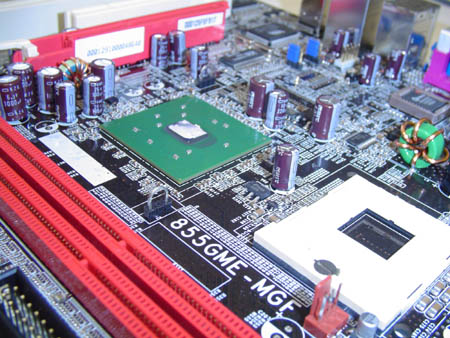Linux and the Desktop Pentium M: Uncommon Performance
by Kristopher Kubicki on December 24, 2004 12:00 PM EST- Posted in
- Linux
A bit about Speed Step, Thermals, Power and Noise
Although this is not the first time that we have looked at Dothan, the exciting bit about the technology is that it requires so little power and thus, so little cooling. The only active cooling required in our Pentium M setup was a 40mm fan on the processor heatsink; the Northbridge is cooled passively.Another reason why we selected the DFI motherboard for this roundup was the fact that it uses such elegant cooling. The HSF combo is proprietary to this motherboard, but it will fit easily in a 1U or SFF case with plenty of clearance and low noise. When we had our test rig setup in an aluminum Hornet Pro SFF chassis from Monarch Computers, we only needed a single, low RPM 80mm fan and the 40mm CPU HSF to cool the rig. At full operation, the Dothan desktop system ran at less than 30 dBA, too low for our Extech devices to even get a measurement at 12".
After a full hour of operation, our BIOS reported the Dothan at a "cool" 98 degrees Fahrenheit. The 40mm fan above is clearly ample enough for our purposes, but we did a little overclocking up to 2.4GHz and the same HSF combo held up fine. More importantly, the combo came free with the motherboard. What interests us even more is that this configuration is not even running Enhanced Speed Step! The 2.6 Linux kernel provides us with an excellent method of adjusting the CPU clock, dubbed "CPU Frequency Scaling". Unfortunately, this option is not enabled by default in most kernel configurations and requires a recompile.
In the .config file of a 2.6.x kernel build directory, we have to change the following lines:
CONFIG_X86_ACPI_CPUFREQ=y CONFIG_CPU_FREQ_GOV_USERSPACE=yBoth lines should now read "y" for yes. After restarting the computer, setting the processor clock speed is as easy as this:
echo 600000 > /sys/devices/system/cpu/cpu0/cpufreq/scaling_setspeedThe sys daemons now will read the scaling file and dynamically clock the processor to 600,000 KHz. Although this amount of control is great for us right now, running a real time daemon to monitor CPU usage would probably be a little more beneficial to us. "cpufreqd" and "speedfreqd" both take control of the CPU scaling and work the same, if not arguably better than the Windows driver that does the same thing. For the tests in this analysis, both daemons were disabled; although, if you plan on getting the most out of your laptop or Dothan desktop, you should run a daemon for the best thermals and power usage.












47 Comments
View All Comments
Adul - Friday, December 24, 2004 - link
stephenbrooks "superlinearly" even a word? Though I do understand what you mean.KristopherKubicki - Friday, December 24, 2004 - link
abakshi: Intel roadmaps say only DDR1 for 915GL.Kristopher
stephenbrooks - Friday, December 24, 2004 - link
The Pentium M scales superlinearly with frequency in a few of the time vs. clock-speed benches (and I'm not talking about the 400->533 FSB improvement), which is pretty interesting. I wouldn't have expected a chip like this to get more efficient at _higher_ clocks.abakshi - Friday, December 24, 2004 - link
Well FSB533 is here, but 800 would be a more significant move with Dothan. A P-M with FSB800, even DDR400 let's say (rather than the DDR2 that should be supported by using a 915 northbridge), and higher clockspeeds - maybe about 2.4-2.6 Ghz - would be amazing.Linux performance will of course depend on other factors such as those mentioned in the article, but the performance under Windows of even the FSB400 2.0 Dothan is awesome -- when overclocked to 2.4Ghz, it's able to keep up with, and at times beat, the latest P4 Prescott and EE's, and A64's, for tasks like gaming:
http://www.gamepc.com/labs/view_content.asp?id=dot...
http://translate.google.com/translate?hl=en&sl...
Lonyo - Friday, December 24, 2004 - link
If Intel gave it a FSB and memory speed boost (ie: 533MHz or 800MHz FSB) and DDR533+, then Dothan could really be something.With Intels talk of dual core processors, a dual core Dothan, with its low heat output, would be awesome (but costly with 2MB of cache).
2x30w = 60w = less than Prescott.
It looks promising, if only Intel would bring it to the affordable desktop :(
VortigernRed - Friday, December 24, 2004 - link
"Although it holds up well against an Athlon 64 3200+,"Although the Dothan looks to be a superb chip you are certainly overstating its performance here, this is comment is WRT the Shake benchmarks and, effectively, the A64 3200 is twice as fast as the dothan. This would be like saying, for example, a R9800XT holds up well against an X800XT or an AXP2200+ holds up well against a A64 3800+ :-)
Also whilst the DDR400 does improve performance it can't help the Dothan where it is really far behind, the kernel compile benchmarks, for instance, it is still 3x slower than any of the other chips on the chart.
Dothan (or really its derivatives) have loads of potential to compete with the A64 on all fronts (Performance, power, heat, with Intels manufacturing, even cost) given enough effort by Intel (which I'm sure they are doing). I can hardly wait to see widespread adoption on the desktop and, frankly, to see the back of the P4. A desktop Celeron PM (1MB l2, lower FSB) could be the new overclocking king.
bersl2 - Friday, December 24, 2004 - link
You might want to ask on the GCC mailing lists (http://gcc.gnu.org/lists.html) about --march=pentium-m.